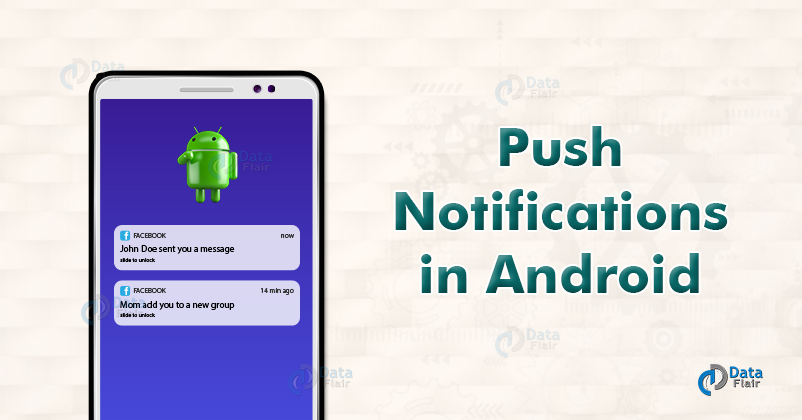Android Push Notification Overview
FREE Online Courses: Your Passport to Excellence - Start Now
In this DataFlair Android Tutorial, we’ll learn about Android Push Notification. Before moving forward with Push Notification, we shall briefly discuss what notification is. So, notification is a simple message that pops up on a device. Either applications can generate Notification or they can be sent from the server to the user. The Notifications can be pushed even when an application is not running. These notifications find use for messages, updates, downloads, etc.
Learn more about Notifications and their types.
Android Push Notification
Push notifications are the first and most important communication channels used in applications today. These days, almost every app that we use makes use of push notifications. Push notification is an evolved technology that has come from the message delivery system.
These days, we have so many apps on our phone that we do not even remember them all. And here, push notification comes into the role; they deliver relevant information to users on time.
Push notifications use two APIs: the Notification API and the second one is Push API. This notification API here lets the app display the notification. The Push API lets the server work, and handle the Push messages even when the app is not in use.
Push Notification Terminologies
There are certain important terms for Notification that we’re discussing below-
- Notification– This is the message which gets displayed to the users outside the apps.
- Push Message- This is the message sent from the server to the users.
- Push Notification– This notification is for Push Message.
- Notification API– This is the interface to configure and display notifications to the users.
- Push API– The interface helps us subscribe to the push service and receive push messages.
- Push Service– This is a system to route the message from the server to clients.
To display a notification we first need to instantiate a NotificationManager, to do this we write the following-
NotificationManager notification_name; Notification_name = (NotificationManager)getSystemService(Context.NOTIFICATION_SERVICE);
After that, we would need to create an instance of Notification class and specify its attributes as follows:
Notification noti_fication= new Notification( android. R. drawable.note, title, System.currentTimeMillis());)
There are certain methods available in the NotificationManager class, such as:
- cancel(int id): It cancels a notification shown previously.
- cancel(String tag, int id): It also cancels a notification shown.
- cancelAll(): It cancels all the messages shown.
- notify(int id, Notification notification): It posts a notification to be shown on the status bar.
- notify(String tag, int id, Notification notification): It also posts a notification to be shown on the status bar.
NOTE: An important thing to note about Push notification is that you can Opt-In or Opt-out for the notification from the application.
- Opt-In: If the user Opts-In for a Push notification, they receive the push notifications from the Application.
- Opt-out: Since there are many applications, it is difficult to manage all the notifications. That’s why the users have the feature to Opt-out of the unwanted Push Notifications.
Uses of Push Notification in Android
Push Notifications best suits for-
- Short messages
- Time-Alert messages
- Nudging customers as a reminder for their purchases and all.
- It improves marketing strategy.
History of Push Notification
Push notifications have a long history; nonetheless, we’ll discuss it and see the following:
- Firstly Push notification came in 2003, by Blackberry Push Email.
- Next was by Apple as Push Service in 2009.
- After that, Google Cloud to Device Messaging(C2DM) came into the role in 2010.
- In 2012, GCM replaced Google C2DM.
- In 2013, Android 4.2 ICS was released; it had Rich Notifications, contained images, and buttons, etc.
- Finally Interactive buttons and interactive changes came to Push Notifications in 2014. It had the feature of Content format, trigger points, and customization scales.
Summary
In conclusion, we can say that Android Push notifications can help android applications. We read the uses of Push notifications as well as we saw the methods for it. We saw the important two APIs required for Push notifications along with the history.
Hope you liked the article. Thanks you!!!
Did you know we work 24x7 to provide you best tutorials
Please encourage us - write a review on Google


